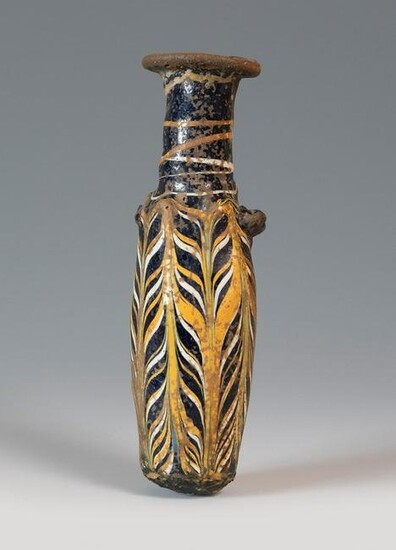Alabastron; Greece, 3rd century BC. Glass. It presents
Alabastron; Greece, 3rd century BC.
Glass.
Private collection J. Martà , Barcelona, Spain. Acquired at the Barcelona art market in the 1990s.
It is in a good state of preservation with slight damage caused by the passage of time.
Measurements: 13 cm (height).
Greek perfume burner following the alabastron typology, made in cobalt blue glass with the core technique and decorated with yellow and white glass threads applied hot and dragged, forming bands that cover the whole piece. The piece has a stylised ovoid belly that tapers towards the shoulders, from which two small handles, one of which is missing, emerge. The narrow neck ends in a wide, flat mouth, which facilitates the dispensing of the perfumed oil and its application to the skin.
The core technique appeared in Mesopotamia around 1500 BC, and first flourished in Egypt between 1500 and 1200 BC. A second flourishing will take place throughout the Mediterranean between the 6th and 1st centuries BC. It will be the most widely used technique until the discovery of blown glass in Roman times, when it will disappear definitively. It consists of preparing the mass by placing the different substances in a crucible, where they are heated until they melt together. It is then left to cool and the surface is scraped, using only the centre, which is where the glass is purest. This process is repeated several times until the glass paste is as pure as possible. A core is then formed in the approximate shape of the desired piece with a mixture of clay, dung and straw, and is pricked on the end of a rod. This core was then covered with glass by dipping it into the crucible or, for a better result, by covering it with hot glass cords wrapped around it. To smooth it, the piece was rolled on a flat surface. This type of piece would be decorated, as we see here, with coloured glass threads, winding them around, especially using shades of yellow, white and turquoise. Normally zig-zag or wavy lines are composed, dragging the threads slightly with a punch, always with the glass tempered so that it melts. The details of the mouths, handles, feet, etc., were made with tweezers and pliers, or by adding a little more glass. Finally, the piece is left to cool slowly in the kiln, and once it has cooled, the rod is removed and the core is taken out, crumbling it with the help of a punch. This technique limits the size of the pieces, which must be small. The pieces from the Second Flourishing period, to which this alabastron belongs, show the same colours and decorations as those from the first period, but differ from the earlier ones in their typology, which is now derived from Greek ceramics.
Estimate
Time, Location
Auction House
Alabastron; Greece, 3rd century BC.
Glass.
Private collection J. Martà , Barcelona, Spain. Acquired at the Barcelona art market in the 1990s.
It is in a good state of preservation with slight damage caused by the passage of time.
Measurements: 13 cm (height).
Greek perfume burner following the alabastron typology, made in cobalt blue glass with the core technique and decorated with yellow and white glass threads applied hot and dragged, forming bands that cover the whole piece. The piece has a stylised ovoid belly that tapers towards the shoulders, from which two small handles, one of which is missing, emerge. The narrow neck ends in a wide, flat mouth, which facilitates the dispensing of the perfumed oil and its application to the skin.
The core technique appeared in Mesopotamia around 1500 BC, and first flourished in Egypt between 1500 and 1200 BC. A second flourishing will take place throughout the Mediterranean between the 6th and 1st centuries BC. It will be the most widely used technique until the discovery of blown glass in Roman times, when it will disappear definitively. It consists of preparing the mass by placing the different substances in a crucible, where they are heated until they melt together. It is then left to cool and the surface is scraped, using only the centre, which is where the glass is purest. This process is repeated several times until the glass paste is as pure as possible. A core is then formed in the approximate shape of the desired piece with a mixture of clay, dung and straw, and is pricked on the end of a rod. This core was then covered with glass by dipping it into the crucible or, for a better result, by covering it with hot glass cords wrapped around it. To smooth it, the piece was rolled on a flat surface. This type of piece would be decorated, as we see here, with coloured glass threads, winding them around, especially using shades of yellow, white and turquoise. Normally zig-zag or wavy lines are composed, dragging the threads slightly with a punch, always with the glass tempered so that it melts. The details of the mouths, handles, feet, etc., were made with tweezers and pliers, or by adding a little more glass. Finally, the piece is left to cool slowly in the kiln, and once it has cooled, the rod is removed and the core is taken out, crumbling it with the help of a punch. This technique limits the size of the pieces, which must be small. The pieces from the Second Flourishing period, to which this alabastron belongs, show the same colours and decorations as those from the first period, but differ from the earlier ones in their typology, which is now derived from Greek ceramics.



